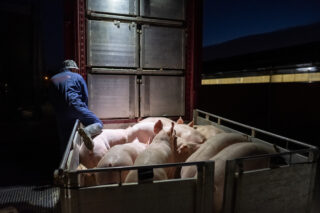Mycotoxins are naturally occurring toxic metabolites posing a risk to humans as well as animals. Despite progress in diagnostic tools and solutions, full prevention of mycotoxins is very difficult. A continuous awareness and complete view on the agri-food chain is required to manage the risk of mycotoxins. Heading towards more than 9 billion people by 2050 we are facing a tremendous challenge to provide everybody with sufficient, healthy and safe food. In terms of safety, toxic substances should be avoided maximally to preserve animal and human health. However, as more extreme weather conditions arise and the competition between food and feed increases, the risk of mycotoxin exposure is expected to increase.

From field to fork
Production of mycotoxins in the field or during storage depends on many factors including temperature, humidity and stress factors. Despite preventive measures most feedstuffs are contaminated by at least one mycotoxin. Although mycotoxin formation is strongly correlated with the geographical regions, the global trade causes a cross-contamination of most mycotoxins all over the world.
Human exposure to mycotoxins is mainly caused by direct consumption of plant-derived foods such as cereals, nuts, seeds and fruits, while exposure via animal-derived food (e.g. meat, milk, eggs) is very limited and of lower public health concern. One exception is aflatoxin M1 present in milk in case of aflatoxin B1 ingestion by dairy cattle. Aflatoxin is carcinogenic and its presence in food and feed is strictly regulated by governmental authorities. Despite the limited risk of mycotoxins passing from the feed to food chain, mycotoxins can have a serious impact on the efficiency in animal production.

Mycotoxin in animal production
Mycotoxin problems are difficult to diagnose at farm level. In the minority of cases, mycotoxins are present at high contamination levels resulting in clinical symptoms. Vomiting, swollen vulva, oral lesions and swollen kidneys are some symptoms that can be related to specific mycotoxins. In most cases however, mycotoxins are present at low levels resulting in subclinical effects. The outcome is a reduced and less efficient (re)production, increased vulnerability for diseases and an overall lower health status. Due to unspecific effects mycotoxins are often missed as a cause of problems and can therefore be considered a hidden risk.
Risk management
Independently of the geographical region, most feed producers worldwide recognize the effect of mycotoxins on animal health and performance. In order to manage the risk of mycotoxins, a control plan is often in place starting with a thorough screening process avoiding the use of contaminated raw materials
However, despite measures taken, it is not always possible to fully avoid mycotoxins in final feeds and their negative effects on the animal. This can be explained by a number of factors:
- Availability of high-quality raw materials depends on the year-to-year weather conditions, market conditions, prices and formulation needs
- The outcome of raw material screening heavily depends on the quality of sampling
- Not all raw materials are screened on all mycotoxins
- Masked mycotoxins are not detected during screening
- Emerging mycotoxins might pose a risk we are not aware of
- Low levels of multiple mycotoxins might result in synergistic effects
- Mycotoxins are highly stable and resistant to feed manufacturing processes
- It is difficult to predict the farm specific conditions
- Limited knowledge and research to the interactions between mycotoxins and pathogens

Proven strategies
An effective strategy to prevent negative effects should work independently of the many uncertainties previously mentioned. In this regard, application of mycotoxin binders in feed offers a great tool as they capture any present mycotoxins in the gastro-intestinal tract preventing mycotoxin absorption in the animal. However, not all toxin binders are evenly effective. The effectiveness of any mycotoxin adsorbent has to be tested, performing in vitro and in vivo evaluations, to demonstrate a statistically significant response in the prevention of mycotoxicosis (Table 1). In the in vivo trial, not only performance but also the protection of target organs or biomarkers linked to specific mycotoxins should be evaluated. Moreover, an effective toxin binder should have consistent quality results demonstrated around the world and remain effective after feed manufacturing processes.
Table 1: Beneficial effect of Vitafix on performance and oral lesions of
broilers fed T-2 toxin from 10 to 39 days of age
| Treatment | Body weight gain (g) | FCR | # of birds with oral lesions | Incidence of oral lesions* |
| Control | 2016 a | 1.75 a | 1/18 | 0.50 a |
| 1.25 ppm T2 Toxin | 1746 b | 1.94 b | 15/18 | 28.50 c |
| 1.25 ppm T2 Toxin + Vitafibra | 1972 a | 1.75 a | 5/18 | 7.50 b |
a,b,c Means within columns with no common superscripts differ significantly (P≤0.05) Number of birds with oral lesions x severity of lesions (score 0-3)
For feed producers, farmers and veterinarians it is often a challenge to find out the real cause of problems. It is even not always clear whether the preventive measures are really effective. Evaluation of macro- and microscopic lesions at farm or slaughterhouse level offers a great additional tool to evaluate the damage of mycotoxins and can also serve to check whether any preventive measures, e.g. application of a toxin binder in feed, are effective. Table 2 and
3 show the organ lesions that can be caused by mycotoxins in pigs as well as poultry.
Table 2: Organ lesions due to mycotoxins in poultry
| Organs | Lesion | Cause |
| Oral cavity | Ulcers, plaques | T2/ MAS/ DAS |
| Gizzard | Erosion, ulcer | |
| Proventriculus | Enlargement | Cyclopiazonic acid |
| Liver | Pale, fatty, friable | Liver |
| Gall bladder | Pale content | |
| Beast/ wing/ thigh | Bruises/ hemorrhages | |
| Kidney | Inflammation, urate deposits | Ochratoxin |
Table 3: Organ lesions due to mycotoxins in pigs
| Organs | Lesion | Cause |
| Gastro-intestinal tract | Ulcers, necrosis, hemorrhages | T2 |
| Lung | Edema | Fumonisin |
| Liver | Hepatosis, friable, pale |
Aflatoxin |
| Stomach | Ulcer | |
| Spleen | Size reduction, grayish or whitish | |
| Esophagus | Epithelial desquamation, ulcers | Vomitoxin |
| Stomach | Epithelial desquamation, lymphoid reaction, ulcer | |
| Skin | Eer necrosis, hoof necrosis, tortuous blood vessels | Ergotoxine |
| Kidney | Nephrosis, hypertrophy, whitish spots in surface, cysts | Ochratoxin |
| Spleen | Size reduction, grayish and whitish coloration | |
| Uterus | Hypertrophy | Zearalenone |
| Ovary | Cysts | |
| Vulva | Vulvovaginitis |
A preventive approach, including the thoroughly substantiated range of toxin binders within Agrimprove, combined with the follow up by specialized pathologists ensures a solid strategy to win the mycotoxin battle.
